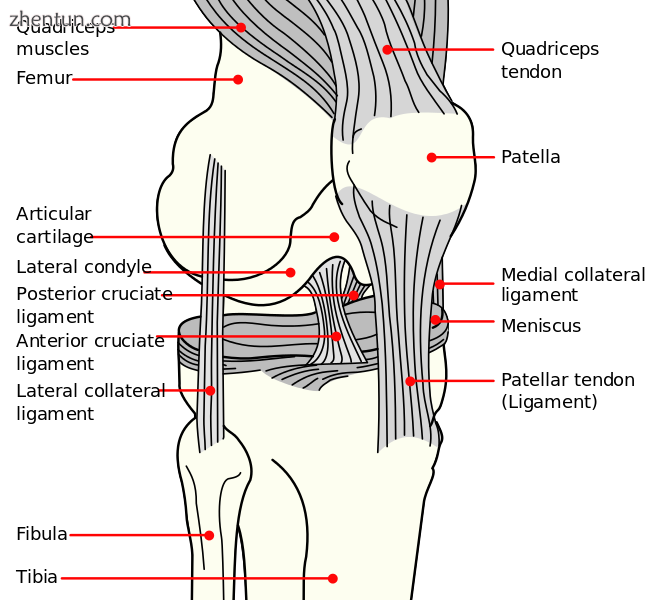
后十字韧带
后十字韧带(或PCL)是膝关节的四个主要韧带之一。它将胫骨的后髁间区域与股骨的内侧髁连接起来。该配置允许PCL抵抗相对于股骨向后推动胫骨的力。
PCL是一种囊内韧带以及前十字韧带(ACL),因为它位于膝关节深处。它们都与充满液体的滑膜腔隔离,滑膜缠绕在它们周围。 PCL的名字来自附着在胫骨的后部。[1]
目录
1 结构
2 功能
3 临床意义
3.1 机理
3.2 治疗
4 其他动物
5 其他图像
6 参考
结构
PCL位于膝关节内,在运动期间稳定关节骨,特别是股骨和胫骨。它起源于内侧股骨髁的外侧边缘和髁间凹陷的顶部[2]然后以后侧和外侧角度向其关节面下方的胫骨后方伸展。[3] [4] [ 5] [6]
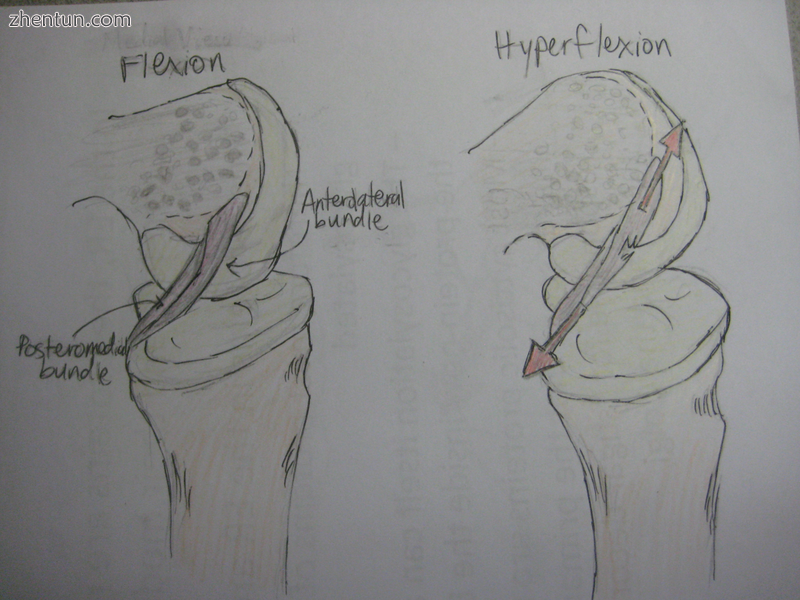
在膝关节伸展的内侧视图中,外侧股骨髁已被移除以显示PCL的结构。由于后内侧束被拉伸并且前外侧束在伸展期间松弛,过度伸展形式的过度伸展导致PCL的后内侧束上的拉伸应力(以红色显示)导致PCL损伤。
功能
虽然每个PCL是一个统一的单元,但它们被描述为单独的前外侧和后内侧部分,基于每个部分的附着位置和功能。[7]在膝关节运动期间,PCL旋转[6] [8],使得前外侧部分在膝关节屈曲时伸展但不在膝盖伸展期间伸展,后内侧束伸展而不是屈曲。[4] [9]
PCL的功能是防止股骨从胫骨的前缘滑落并防止胫骨在股骨后方移位。后十字韧带位于膝盖内。韧带是连接骨骼的坚固组织带。类似于前十字韧带,PCL将股骨连接到胫骨。
临床意义
主要文章:后十字韧带损伤
造成伤害的常见原因是直接撞击弯曲的膝盖,例如膝盖在车祸中击中仪表板或在膝盖上猛烈下落,这两种情况都会使股骨后方的胫骨移位。[10]
后交叉韧带损伤的另一个测试是后部下垂试验,其中与后凹试验相反,没有施加有效力。相反,这个人仰卧,另一个人握住腿,使臀部弯曲90度,膝盖弯曲90度。[11]该测试的主要参数是步进式,即从股骨到假想线的最短距离,该线从胫骨结节向上切向胫骨表面。通常,在后十字韧带损伤时,踩下约1厘米,但减少(一级)或甚至不存在(二级)或反一级(三级)[12]。后抽屉测试是医生和物理治疗师用于检测PCL损伤的测试之一。怀疑患有后交叉韧带损伤的患者应始终评估其他膝关节损伤,这些膝关节损伤通常与PCL损伤相关。这些包括软骨/半月板损伤,骨挫伤,ACL撕裂,骨折,后外侧损伤和侧副韧带损伤。
有四种不同等级的分类,其中医生对PCL损伤进行分类:I级,PCL轻度撕裂。 II级,PCL韧带最小程度地撕裂并变得松散。 三级,PCL完全撕裂,膝盖现在可归类为不稳定。 IV级,韧带与膝盖内的另一条韧带(即ACL)一起受损。 对于这些等级的PCL损伤,可以采用不同的治疗方法来治疗此类损伤。
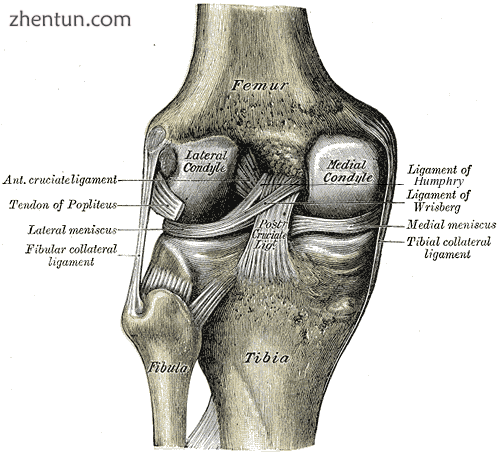
后十字韧带位于膝盖内
机制
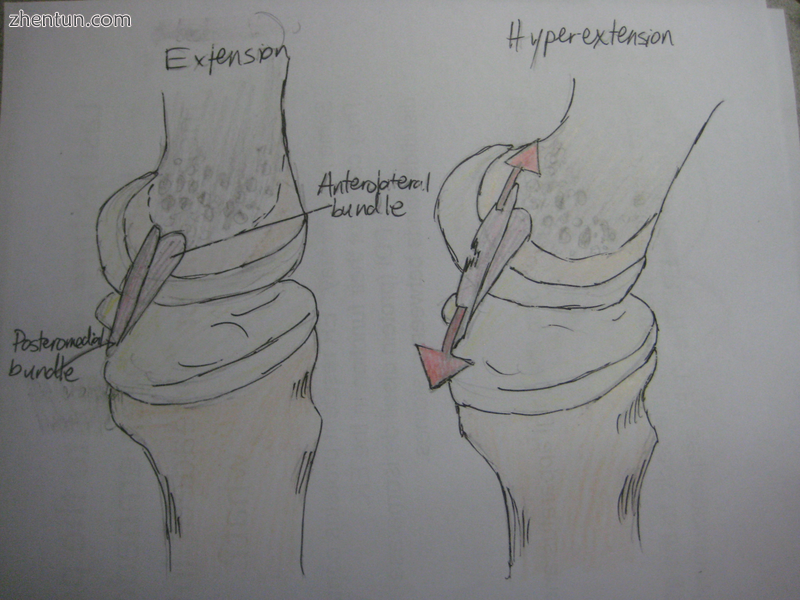
在膝关节屈曲的内侧视图中,已移除外侧股骨髁以显示PCL的结构。因为前外侧束被拉伸并且后内侧束在屈曲期间松弛,过度屈曲形式的过度弯曲导致PCL的前外侧束上的拉伸应力(以红色显示)导致PCL损伤。
在这个位置,PCL的功能是防止胫骨向后方移动[4] [13],并防止髌骨倾斜或移位。[14]然而,两个部分各自的松弛使得PCL在过度弯曲,过度伸展[15]以及称为仪表板损伤的机制中容易受伤。[6]因为韧带是粘弹性的[16],只有当负荷缓慢增加时,它们才能承受更大的应力。[17]当超弹性和过度伸展与这种粘弹性行为相结合突然发生时,PCL会发生变形或撕裂。[15]在第三种也是最常见的机制,即仪表板损伤机制中,膝盖在膝盖弯曲时朝向胫骨上方的空间向后方经受冲击。[7] [15]这些机制发生在过度的外部胫骨旋转和跌倒期间,引起胫骨的伸展和内收的组合,这被称为内翻 - 延伸应力,[7]或膝盖弯曲时发生的[15]。
治疗
PCL可以自行愈合。韧带完全撕裂通常需要手术。手术通常在几周后进行,以使肿胀减少并且定期运动返回膝盖。一种称为韧带重建的手术用于用新韧带代替撕裂的PCL,新韧带通常是来自宿主尸体的腿筋或跟腱的移植物。关节镜允许完整评估整个膝关节,包括膝盖(髌骨),软骨表面,半月板,韧带(ACL和PCL)和关节衬里。然后,用韧带将新韧带固定在大腿和小腿骨上,将其固定到位。[18]由于其放置和技术难度,修复后十字韧带的手术是有争议的。[19]
当PCL为I级或II级伤害时,PCL可以自行愈合而无需手术。通过进行某些康复训练,在这些类别中诊断出的PCL损伤可以缩短其恢复时间。 Fernandez和Pugh(2012)发现,在PCL II级诊断后,进行了为期8周的多模式治疗,包括脊椎按摩治疗,物理治疗和实施强调离心肌肉收缩的锻炼计划(弓步,单腿深蹲)躯干稳定被证明是从PCL损伤中恢复的有效方法。[20]对于III级和IV级,建议或通常需要手术。移植是解决需要手术的PCL损伤的方法对于移植物,有不同的方法,如胫骨镶嵌或隧道法。[21]
其他动物
在四足趾关节(类似于人类膝关节)中,根据其解剖位置,它被称为尾部十字韧带。[22]
其他图片
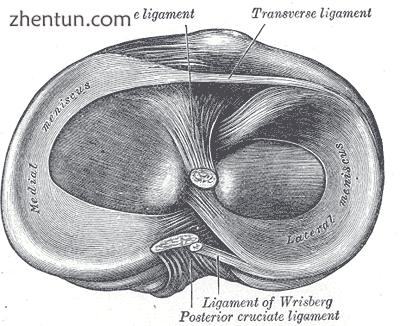
从上面看到的右胫骨头,显示半月板和韧带的附件。
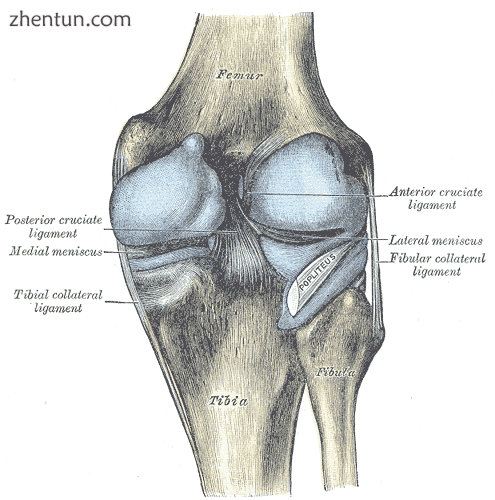
右膝关节囊(扩张)。 后方。
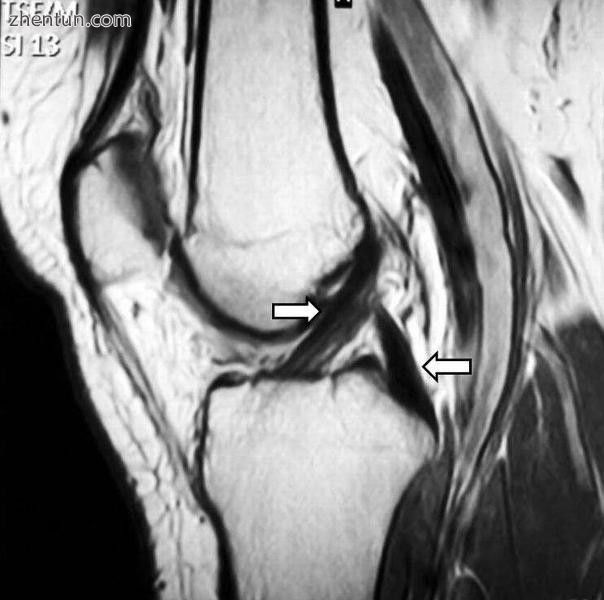
磁共振成像评估显示前交叉韧带和后交叉韧带的正常信号(箭头)。
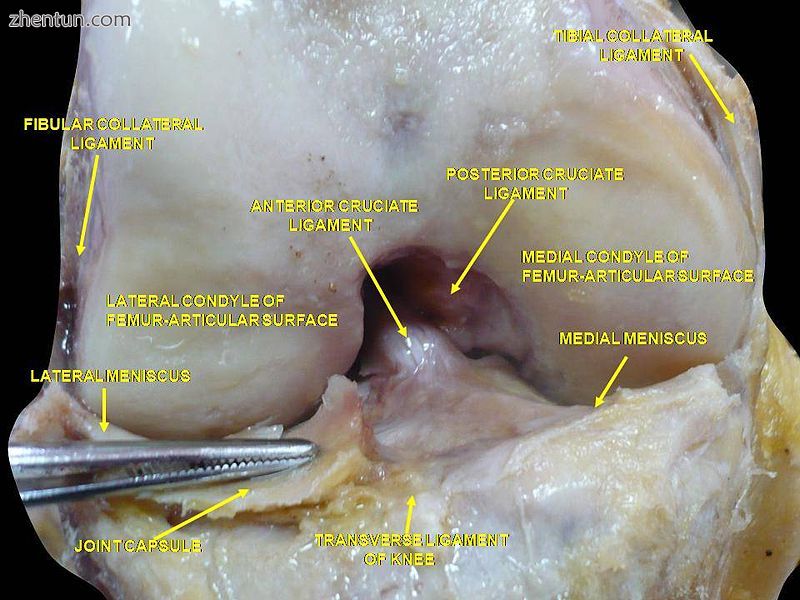
膝盖前视图。
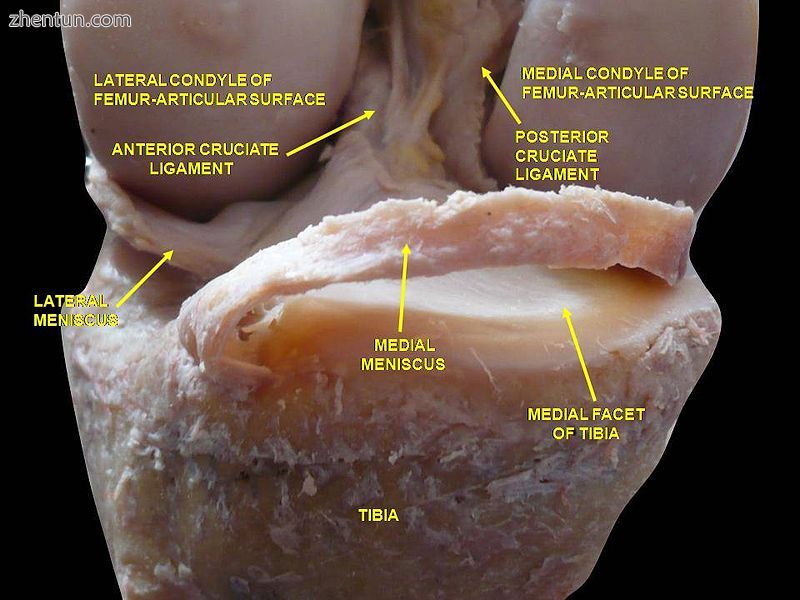
膝关节。 深层解剖。 前视图
参考
Saladin, K. S. 2010. Anatomy & Physiology: 5th edition. McGraw-Hill[page needed]
Amis, AA.; Gupte, CM.; Bull, AM.; Edwards, A. (Mar 2006). "Anatomy of the posterior cruciate ligament and the meniscofemoral ligaments". Knee Surg Sports Traumatol Arthrosc. 14 (3): 257–63. doi:10.1007/s00167-005-0686-x. PMID 16228178.
Girgis, FG.; Marshall, JL.; Monajem, A. "The cruciate ligaments of the knee joint. Anatomical, functional and experimental analysis". Clin Orthop Relat Res. 106: 216–31. doi:10.1097/00003086-197501000-00033. PMID 1126079.
Chandrasekaran, S.; Ma, D.; Scarvell, JM.; Woods, KR.; Smith, PN. (Dec 2012). "A review of the anatomical, biomechanical and kinematic findings of posterior cruciate ligament injury with respect to non-operative management". Knee. 19 (6): 738–45. doi:10.1016/j.knee.2012.09.005. PMID 23022245.
Edwards, A.; Bull, AM.; Amis, AA. (Mar 2007). "The attachments of the fiber bundles of the posterior cruciate ligament: an anatomic study". Arthroscopy. 23 (3): 284–90. doi:10.1016/j.arthro.2006.11.005. PMID 17349472.
Voos, JE.; Mauro, CS.; Wente, T.; Warren, RF.; Wickiewicz, TL. (Jan 2012). "Posterior cruciate ligament: anatomy, biomechanics, and outcomes". Am J Sports Med. 40 (1): 222–31. doi:10.1177/0363546511416316. PMID 21803977.
Malone, AA.; Dowd, GS.; Saifuddin, A. (Jun 2006). "Injuries of the posterior cruciate ligament and posterolateral corner of the knee". Injury. 37 (6): 485–501. doi:10.1016/j.injury.2005.08.003. PMID 16360655.
DeFrate, LE.; Gill, TJ.; Li, G. (Dec 2004). "In vivo function of the posterior cruciate ligament during weightbearing knee flexion". Am J Sports Med. 32 (8): 1923–8. doi:10.1177/0363546504264896. PMID 15572322.
Race, A.; Amis, AA. (Jan 1994). "The mechanical properties of the two bundles of the human posterior cruciate ligament". J Biomech. 27 (1): 13–24. doi:10.1016/0021-9290(94)90028-0. PMID 8106532.
MedlinePlus Encyclopedia Posterior cruciate ligament (PCL) injury
Posterior Sag Test From The University of West Alabama, Athletic Training & Sports Medicine Center. Retrieved Feb 2011
Cole, Brian; Miller, Mark J. (2004). Textbook of arthroscopy. Philadelphia: Saunders. p. 719. ISBN 0-7216-0013-1.
Castle, Thomas H; Noyes, Frank R; Grood, Edward S (1992). "Posterior Tibial Subluxation of the Posterior Cruciate-Deficient Knee". Clinical Orthopaedics and Related Research (284): 193–202. doi:10.1097/00003086-199211000-00027. PMID 1395293.
von Eisenhart-Rothe, Ruediger; Lenze, Ulrich; Hinterwimmer, Stefan; Pohlig, Florian; Graichen, Heiko; Stein, Thomas; Welsch, Frederic; Burgkart, Rainer (2012). "Tibiofemoral and patellofemoral joint 3D-kinematics in patients with posterior cruciate ligament deficiency compared to healthy volunteers". BMC Musculoskeletal Disorders. 13: 231. doi:10.1186/1471-2474-13-231. PMC 3517747. PMID 23181354.
Janousek, Andreas T.; Jones, Deryk G.; Clatworthy, Mark; Higgins, Laurence D.; Fu, Freddie H. (1999). "Posterior Cruciate Ligament Injuries of the Knee Joint". Sports Medicine. 28 (6): 429–41. doi:10.2165/00007256-199928060-00005. PMID 10623985.
Hamill, Joseph; Knutzen, Kathleen (2009). Biomechanical basis of human movemen. Philadelphia: Wolters Kluwer Health/Lippincott Williams and Wilkins. p. 50. ISBN 978-0-7817-9128-1.
Hamill, Joseph; Knutzen, Kathleen (2009). Biomechanical basis of human movemen. Philadelphia: Wolters Kluwer Health/Lippincott Williams and Wilkins. p. 30. ISBN 978-0-7817-9128-1.
http://www.orthspec.com/pdfs/PCL-injuries.pdf[full citation needed]
Jonathan Cluett, M.D. (2003-08-05). "Injuries to the posterior cruciate ligament (PCL)". about.com. Retrieved 2006-11-11.
Fernandez, Matthew; Pugh, David (2012). "Multimodal and interdisciplinary management of an isolated partial tear of the posterior cruciate ligament: a case report". Journal of Chiropractic Medicine. 11 (2): 84–93. doi:10.1016/j.jcm.2011.10.005. PMC 3368977. PMID 23204951.
Wind, William M.; Bergfeld, John A.; Parker, Richard D. (2004). "Evaluation and Treatment of Posterior Cruciate Ligament Injuries: Revisited". American Journal of Sports Medicine. 32 (7): 1765–75. doi:10.1177/0363546504270481. PMID 15494347.
Blood, Douglas C.; Studdert, Virginia P.; Gay, Clive C., eds. (2007). "Cruciate". Saunders Comprehensive Veterinary Dictionary (3rd ed.). Elsevier. ISBN 978-0-7020-2788-8. Retrieved September 8, 2009. |